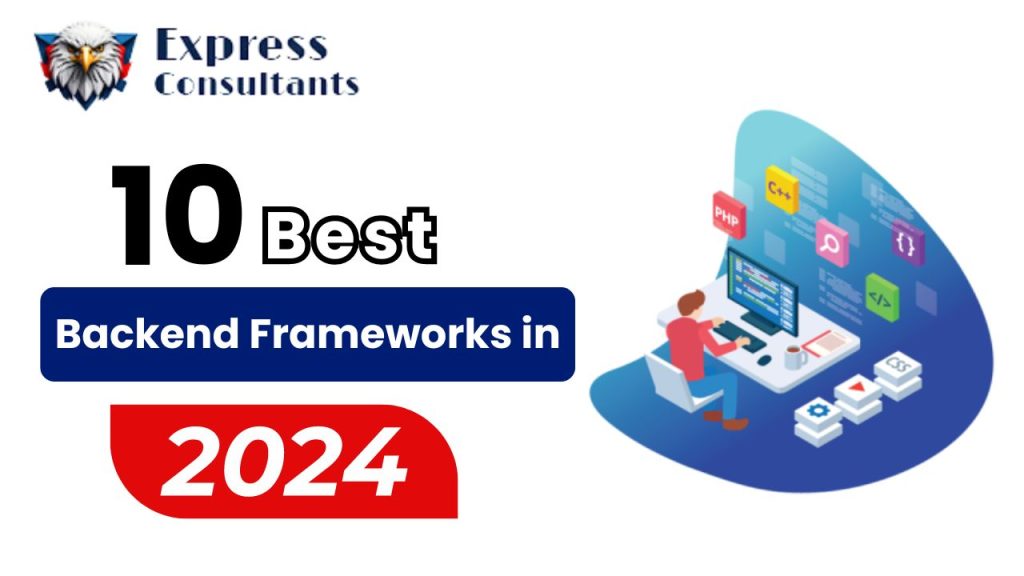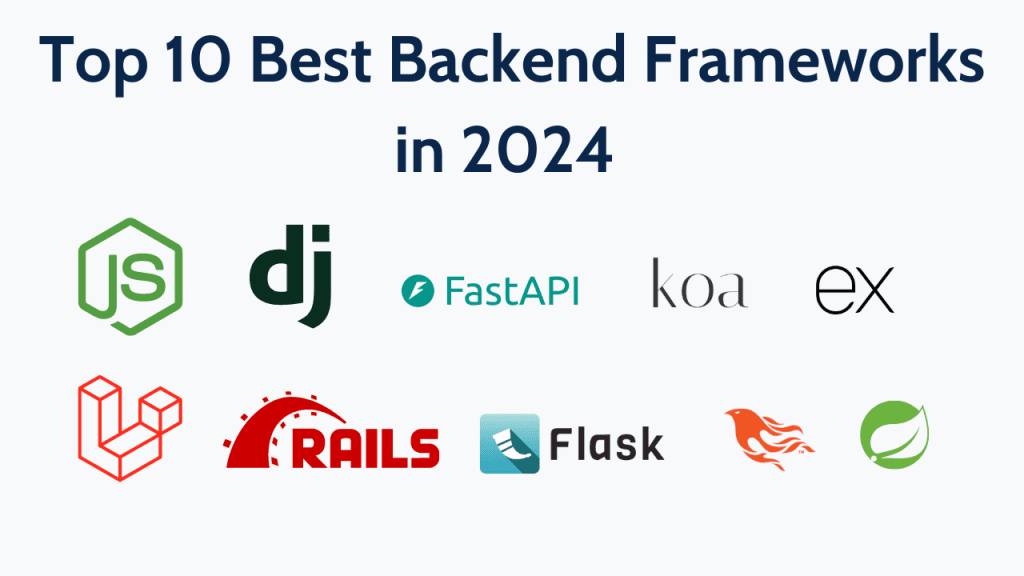
10 Best Backend Frameworks in 2024
September 12, 202410 Best Backend Frameworks in 2024
The backbone of any successful web or mobile application often lies in the framework that powers it. Choosing the best backend framework is no longer a luxury—it’s a necessity for building scalable, efficient, and fast applications. So, what’s changed in 2024? And which backend frameworks are leading the pack? Let’s dive into it.
What Are Back-End Frameworks?
In simple terms, backend frameworks are the unsung heroes behind the curtain, ensuring that everything on a website or app functions smoothly. When you use an app and click a button, the backend framework ensures that the right data is fetched, processed, and sent back to the front end without hiccups. It’s like the kitchen in a restaurant—you don’t see it, but you rely on it to make everything work.
These frameworks simplify the development process, providing pre-built modules and structures so developers don’t have to start from scratch every time. It’s like having a LEGO set instead of building bricks from mud. Pretty cool, right? In 2024, the demand for more sophisticated frameworks has skyrocketed, and developers are spoiled for choice.
Why Use a Backend Framework?
Why reinvent the wheel when backend frameworks offer tried-and-true solutions for common issues? Here are a few reasons:
- Faster Development: Pre-built components save time.
- Scalability: Designed to grow with your application.
- Security: Robust frameworks come with built-in security features.
Alright, enough chit-chat. Let’s talk about the best backend frameworks of 2024.
The 10 Best Backend Frameworks in 2024

1. Node.js
Node.js remains a top contender in 2024. It’s fast, lightweight, and perfect for real-time applications. Think of apps like Slack and Trello—they run on Node.js because it handles asynchronous tasks brilliantly. What makes it stand out? It’s built on JavaScript, meaning full-stack developers can use one language for both front-end and back-end tasks. If you’re familiar with JavaScript, you can hop on the Node.js bandwagon without missing a beat.
Benefits Node.js
- JavaScript for full-stack development: Use one language (JavaScript) for both frontend and backend.
- Non-blocking architecture: Handles multiple tasks simultaneously, making it perfect for real-time apps.
- Lightweight and scalable: Great for applications expected to grow and handle high traffic.
- Large community: Extensive resources, tutorials, and libraries available for developers.
2. Django
Python lovers, rejoice, Django continues to shine as a secure, high-level Python framework that simplifies web development. Used by giants like Instagram and Pinterest, Django’s “batteries included” philosophy gives developers everything they need, right out of the box. Plus, it’s known for its focus on security, which is huge in 2024, especially with the growing concerns about data breaches.
Benefits of Django
- “Batteries included”: Comes with everything needed to build secure, scalable web applications.
- High security: Built-in security features like SQL injection prevention and cross-site request forgery protection.
- Great for rapid development: Offers reusable code and automatic admin panels, speeding up the development process.
- Strong Python ecosystem: Integrates well with data science and machine learning projects.
3. Ruby on Rails
This veteran framework is still hanging in there, and for good reason. Ruby on Rails is loved for its simplicity and productivity. The framework encourages convention over configuration, making it easier for developers to jump right in. You can build powerful applications without sweating over the small stuff. Oh, and did we mention Basecamp and Shopify use it?
Benefits of Ruby on Rails
- Convention over configuration: Speeds up development by reducing the need for decision-making about structure.
- Large number of pre-built libraries: Comes with “gems” that allow developers to easily add functionality.
- Developer-friendly: Focuses on simplicity and productivity, making it ideal for quick development.
- Mature ecosystem: Proven reliability with long-term support and a dedicated community.
4. Laravel
For PHP fans, Laravel is the backend framework to watch. It’s elegant, easy to understand, and brings simplicity to complex PHP coding. Laravel’s ecosystem is rich with tools and libraries that make authentication, routing, and caching a breeze. Plus, with the community continuing to grow, you can always find a package or plugin for just about anything you need.
Benefits of Laravel
- Elegant syntax: PHP framework with clean, readable code.
- Rich ecosystem: Offers a wide range of tools for authentication, routing, sessions, and caching.
- Excellent for beginners: Simple to pick up, even if you’re new to PHP.
- Security features: Includes built-in protection against common vulnerabilities.
5. Flask
While Django is the go-to for full-featured applications, Flask is the minimalist counterpart. It’s a lightweight Python framework that gives developers flexibility and control. Flask is perfect for small projects or APIs. Developers love it because it allows them to get something up and running quickly without being tied down by too many built-in features.
Benefits of Flask
- Lightweight: Minimalistic, giving developers more flexibility and control.
- Great for small projects or APIs: Perfect for creating smaller apps or microservices without extra bloat.
- Easy to learn: Ideal for developers who want a simple framework with fewer built-in features.
- Highly customizable: Allows you to build only what you need.
6. Spring Boot
Java developers, unite, Spring Boot remains a popular choice in 2024, particularly for enterprise-level applications. It simplifies Java development, offering microservice architecture capabilities. Companies like Netflix and Amazon swear by Spring Boot for handling their massive infrastructures, so you know it’s reliable.
Benefits of Spring Boot
- Microservice architecture: Ideal for building large-scale, distributed systems.
- Enterprise-grade: Trusted by major companies like Netflix and Amazon.
- Java-based: Great for Java developers who need a robust framework.
- Strong performance: Efficient memory management, making it suitable for high-performance apps.
7. Express.js
If you’re into Node.js, you’ve likely heard of Express.js. It’s a minimal and flexible Node.js framework that provides a solid foundation for developing web applications and APIs. The learning curve is low, and it’s highly scalable, making it a go-to framework for many companies in 2024. If you’re building a single-page app or a REST API, Express.js is your friend.
Benefits of Express.js
- Minimal and flexible: Simple, yet highly customizable for Node.js developers.
- Perfect for APIs: Great for building RESTful APIs quickly and efficiently.
- Scalable: Can handle small applications or large-scale projects with ease.
- Active community: Plenty of libraries and resources to help developers.
8. Phoenix (Elixir)
Phoenix is built on Elixir and brings speed and scalability to the table. In 2024, it’s gaining traction because of its real-time capabilities, which are crucial for chat applications, gaming, and financial services. The Elixir ecosystem ensures that applications are fault-tolerant and can handle massive traffic without crashing.
Benefits of Phoenix (Elixir)
- Real-time capabilities: Ideal for chat applications, gaming, or financial services.
- Fault-tolerant: Can handle high traffic without crashing, making it incredibly reliable.
- Concurrency: Uses Elixir’s powerful concurrency model, allowing it to handle thousands of connections simultaneously.
- Performance: Highly optimized for speed and scalability.
9. Koa.js
Another framework built by the creators of Express.js, Koa is even more lightweight, focusing on making the middleware more customizable and less bulky. Developers love it for its simplicity and flexibility, which allows them to create more modular applications. If you’re looking for a modern take on the backend, Koa.js is worth checking out.
Benefits of Koa.js
- Modern and lightweight: Built by the creators of Express.js, but with fewer restrictions and more flexibility.
- Customization: Offers more control over the middleware stack, allowing for cleaner and more modular code.
- Small footprint: Great for developers who want minimalism without sacrificing functionality.
- Improved error handling: Handles errors better than Express.js, making debugging easier.
10. FastAPI
As the name suggests, FastAPI is all about speed. This Python-based framework has been rising in popularity due to its ability to create fast web APIs. If you’re dealing with high-performance applications like machine learning or data science projects, FastAPI is a fantastic choice. It’s one of the fastest-growing frameworks in 2024, and we’re not surprised.
Benefits of FastAPI
- Incredibly fast: One of the fastest backend frameworks, perfect for high-performance APIs.
- Asynchronous support: Built-in support for asynchronous requests, which speeds up the application.
- Python-based: Leverages Python’s simplicity while focusing on speed.
- Automatic documentation: Automatically generates interactive API documentation, which is super helpful for developers.
Each framework brings unique advantages, so choosing the best one depends on your specific project needs, whether it’s speed, scalability, security, or ease of development.
Top 10 Best Backend Frameworks in 2024 Key features and Best Use Cases of every Framework
| Framework | Key Features | Best Use Cases |
| Node.js | Non-blocking, event-driven architecture; JavaScript for full-stack development | Real-time apps (e.g., chat, collaboration tools) |
| Django | High security; “Batteries included” philosophy | Large, scalable web applications; secure apps |
| Ruby on Rails | Convention over configuration; large library of gems | Quick MVP development, startups |
| Laravel | Elegant syntax; rich ecosystem with built-in tools | Web applications requiring authentication, sessions, and more |
| Flask | Lightweight and flexible; minimalistic design | Small projects, microservices, APIs |
| Spring Boot | Microservice-friendly; enterprise-grade performance | Large-scale distributed systems, enterprise apps |
| Express.js | Minimal, flexible; ideal for APIs | Building RESTful APIs, web apps |
| Phoenix | Real-time performance; fault-tolerant | High-traffic apps, real-time web apps (e.g., gaming) |
| Koa.js | Lightweight; modern and flexible | Modular web applications |
| FastAPI | Asynchronous support; automatic API documentation | High-performance APIs, Python-based systems |
Advantages of Using the Best Backend Frameworks in 2024
Here’s the deal: in 2024, the best backend frameworks make a developer’s life easier by offering a host of advantages. First off, they provide better security features. It’s like having a burglar alarm for your app, With cyber-attacks becoming more sophisticated, frameworks like Django and Laravel are stepping up their security game.
Not to mention, they speed up the development process. Time is money, and these frameworks ensure you can launch your app quicker. Plus, scalability is a huge bonus—when your app grows, the framework grows with it. Imagine your app being able to handle millions of users without breaking a sweat. That’s the magic of choosing the right backend framework.
And let’s not forget about the community support. Frameworks like Node.js and Laravel boast massive communities. This means if you hit a roadblock, you’ve got thousands of developers who can lend a hand. Talk about a support network.
Somes Other Benefits of Using a Backend Framework
Using a backend framework in 2024 means more than just getting the job done. You’re investing in the future of your project. Think about it: these frameworks handle the heavy lifting, allowing you to focus on what matters—building great features for your users. They’re efficient, scalable, and battle-tested.
Frameworks like Express.js and FastAPI also make it easy to create APIs that can be integrated into other applications. Need real-time communication for a chat app? Phoenix has you covered. Want something that handles asynchronous tasks seamlessly? Node.js is the answer.
Conclusion
In 2024, choosing the best backend frameworks isn’t just about trends—it’s about ensuring your project’s success. Whether you’re building a small app or managing a large-scale enterprise project, these frameworks offer the tools and support you need. From the robust security of Django to the speed of FastAPI, there’s a framework for every developer’s needs. Ready to take your next project to the next level? Dive into these frameworks and see how they transform your development experience.
You may also like: –
- Why Your Online Business Needs AI-Powered Chatbots
- Building a Custom Website Design vs. Using a Template: Which One Is Right for You?
FAQ
1. What is a backend framework?
A backend framework is like the engine of a car—it powers everything behind the scenes. It helps developers build the logic that runs an app or website, handling tasks like database interactions, user authentication, and server-side processing. In short, it makes the app work smoothly without you seeing all the magic happening in the background.
2. Why are backend frameworks important in 2024?
In 2024, backend frameworks are more critical than ever because they provide built-in solutions for security, scalability, and speed. With users demanding faster, more secure apps, having the right framework can make or break your project. These frameworks are designed to handle complex applications and ensure everything runs without a hitch—even as your app grows.
3. What are the best backend frameworks in 2024?
The top backend frameworks this year include:
- Node.js
- Django
- Ruby on Rails
- Laravel
- Flask
- Spring Boot
- Express.js
- Phoenix (Elixir)
- Koa.js
- FastAPI
Each of these has its strengths, from security to speed, depending on what your project needs.
4. Which backend framework is the fastest in 2024?
FastAPI lives up to its name and is considered one of the fastest backend frameworks in 2024. If speed and performance are top priorities for your app, especially for APIs, FastAPI should definitely be on your radar.
5. What makes Node.js so popular in 2024?
Node.js continues to dominate because it’s built on JavaScript, meaning developers can work on both frontend and backend using a single language. Its non-blocking, event-driven architecture makes it perfect for real-time applications like chat apps and collaborative tools. Plus, it’s lightweight and extremely scalable.
6. Is Django still relevant in 2024?
Absolutely, Django is one of the most secure and comprehensive backend frameworks out there. In an era of rising cyber threats, Django’s focus on security makes it a top choice for developers in 2024.
7. What’s the difference between Flask and Django?
Django is a full-featured framework that comes with a lot of built-in tools, making it perfect for large, complex applications. Flask, on the other hand, is much more lightweight and gives developers more flexibility and control, making it a better option for smaller projects or when you don’t need all the extras.
8. What framework should I use if I want to build a scalable app?
If you’re thinking big and want an app that can scale easily, frameworks like Node.js, Spring Boot, and Phoenix are great choices. These frameworks are built to handle heavy traffic and can grow with your app, making them ideal for large-scale projects.
9. Are backend frameworks beginner-friendly?
Some are more beginner-friendly than others. For example, Laravel and Flask are relatively easy to pick up, even if you’re new to backend development. On the other hand, frameworks like Spring Boot might have a steeper learning curve due to their complexity but are great for more experienced developers.
10. Why should I care about community support when choosing a backend framework?
The more popular the framework, the larger the community—this means more tutorials, plugins, and troubleshooting help when you’re stuck. Frameworks like Laravel, Node.js, and Django have massive communities behind them, so if you run into issues, you won’t have to figure things out alone.
Ready to unlock your business's potential with custom software
Contact Us


